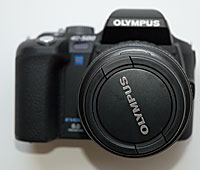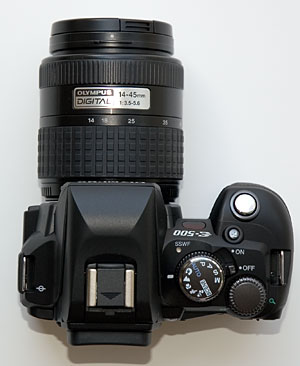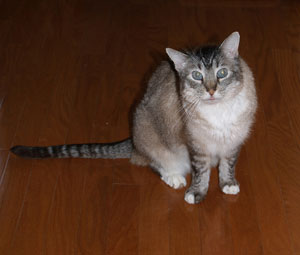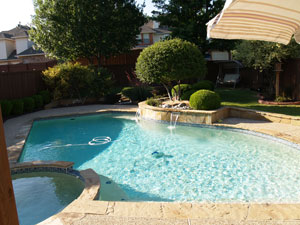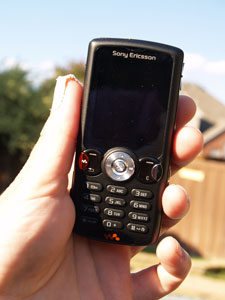|
|||||||||
Advertisement |
Home -> Gadget Reviews -> Olympus EVOLT E-500 Olympus EVOLT E-500Editor's rating (1-5): Reviewed July 6, 2006 by Lisa Gade, Editor in Chief Digital photography and I go way back. My first digicam was the Apple QuickTake, a VGA affair that looked more like an underwater exploration pod than a camera. Needless to say 1) I've been using these things for a long time 2) I had film SLR cameras for those times I wanted to take "real" pictures. Well, those days have long passed and film cameras are going the way of the dinosaurs. Digital has gotten that good, both in the point and shoot and SLR segments. The drawback is high end dSLRs can set you back over $2,000 (and that's just for the body). The bright spot is that prosumer, "entry level" digital SLR cameras can be found for just under $1,000, with a few being significantly under that price, including a kit lens. That's a lot more than their film counterparts, but not much more than a high end digital point and shoot.
The Olympus EVOLT E-500 is one of the bargains among entry level digital SLR cameras. For around $799 you get the 8 megapixel camera and two kit lenses covering the most commonly used ranges in photography. Nice. Unlike the tepidly received EVOLT E-300 which was quite high tech and eschewed too much of the standard SLR design (it was a flat-top with no pentaprism and had a 4:3 aspect ratio instead of the normal film ratio), the E-500 is the more "normal" dSLR we'd hoped Olympus would produce with a pentaprism. They still keep the 4:3 ratio, but that will be covered later and isn't necessarily a bad thing. The E-500 is one of the more compact and lightweight digital SLRs, weighing in at 15.34 ounces, with controls and menus systems that a relative novice can easily comprehend. The camera's black polycarbonate plastic housing feels solid, and all dSLRs in this price range have plastic bodies, not metal. It comes with everything you need to get going other than a memory card and no digital SLR comes with a memory card in the box. It feels good in the hands, and is a bit larger and more solid feeling than the Canon Digital Rebel XT (which men often complains feels too small in the hand). The thing to know about Olympus is that they've gone full force into digital and quit film altogether. That means that they have a nice range of digital-only lenses (the Zuiko digital line) which are a perfect match for the dSLR's sensor size and cpu. As of this writing, Olypmus has 14 Zuiko digital lenses from fisheye to ultrawide zoom to macro and long teles. Prime lens lovers should note that Olympus offers only macro and long telephoto primes, though the 35mm and 50mm macros work well as "regular" non-tele prime lens. Since lenses are equally as important as the body when it comes to image quality, and you might find yourself growing into different shooting scenarios which call for additional lens types or simply better lenses, it's important to know that the selection is there. Though some folks call Zuiko lenses expensive, they are in the middle of the pack when compared to Canon and Nikon's offerings. The other important thing is that Olympus is the only digital SLR manufacturer to offer cameras with sensor cleaners. The E-500 has a built in "Supersonic Wave Filter" sensor cleaner that runs each time you turn on the camera (it vibrates 35,000 times per second to shake off dust). Dust generally gets on the sensor when you change lens. This happens with film cameras, but the film itself is the sensor, and it obviously gets changed with each frame and roll of film, unlike a permanent digital sensor. Now, it's not all that hard to clean a dSLR sensor yourself (a cleaning is in order when you notice spots in your picture, most easily seen in areas of continuous tone like a blue sky). But entry level dSLR buyers are less likely to want to muck around the innards of a $1,000 piece of equipment, so the feature is compelling. |
|
What the Camera Can Do
The E-500 accepts both CF cards (type I, II and MicroDrive) and Olympus' own xD-Picture Card media, has a large and bright 2.5" LCD and a somewhat small viewfinder with 95% coverage and diopter adjustment. The viewfinder tells you most everything you need to know, and this is pretty much the only SLR which uses the back LCD for further information since it lacks the usual top monochome status LCD window. Once you get used to this, it's not bad, though the big 2.5 color LCD does use power and hence it's usually off on other cameras except for post-shot viewing and menu navigation. The camera can take photos in JPEG, TIFF and RAW formats at a maximum resolution of 3264 x 2448. It's compatible with USB 2.0 but supports only a max of 12 Mb/s which is USB 1.1 High Speed rather than 480 Mb/s USB 2.0 Full Speed connections to PCs and Macs and can output to a TV via the included video cable.
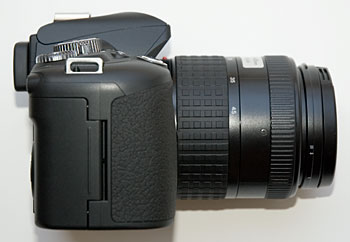
The camera with the kit 14-45mm zoom lens.
As you'd expect from an SLR, you can shoot in a variety of manual modes (program, aperture priority, shutter priority and full manual) or choose from auto and a variety of Scene modes (sports, portrait, macro, landscape, night and a custom scene). The E-500 has a 3 point auto focus system (not impressive compared to Canon and Nikon's entry level offerings) and supports manual focus as well as continous auto focus. That said, the AF works quite well and we weren't plauged by soft shots. The camera can take continuous shots at 2.5fps up to 4 frames in RAW or until the card is filled before it runs out of buffer (assuming a very fast CF card is used). That's good enough to capture the grandkids but not fast enough for serious sports coverage. It has a maximum shutter speed of 1/4000 down to 60 seconds in the non-automatic modes and has a self timer. The built in TTL flash has a guide number of 13 (average for its class) and it offers red eye reduction, slow sync and fill flash with a 1/180th sync speed (a little slow, Canon does 1/250 and Nikon does 1/500th). You can manually control the flash up to +/- 2EV.
For an entry level digital SLR, the EVOLT E-500 sports a few high end features such as exposure bracketing, white balance bracketing and ISO that goes all the way down to 100 (Nikon and Pentax low models and even the D70s only go down to 200) up to 400 in auto or 1600 in manual. You can set ISO in 1/3EV increments and set metering to Digital ESP (full frame evaluation), center weighted or spot (some Canon's have been missing spot). Metering was very good in our tests and it only failed us on some of the most challenging shots (contrasty and backlit scenes). But for a camera in this price range, it did a good job.
What's in the Box
The E-500 is available in three configurations: body only, single zoom lens bundle and two zoom lens bundle. The two lens bundle is what you'll find in most stores and represents the greatest value for the money (unless you're into high end glass and want better lenses immediately). Since the EVOLT targets entry level folks, their assumption and mine is that you'll be happy enough with the bundled lenses, making this a great deal for the average buyer. In fact, for the price, the included lenses are decent. Kit lenses are often not the best, but the two zooms make for sharp shots without a hideous amount of pin cushion or barrel distortion.
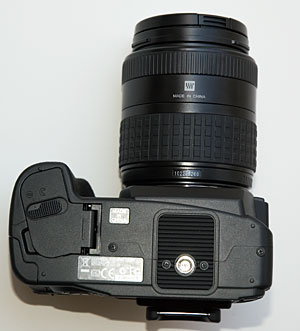 |
Notice there's no top LCD! |
Olympus includes the camera, a neck strap, viewfinder cover (for long exposure remote shots), 14-45mm f3.5/5.6 Zuiko Digital Zoom Lens, 40-150mm f3.5/4.5 Zuiko Digital Zoom Lens, a hood for each lens (nice touch, those are usually sold separately), Lithium Ion battery (sorry, it doesn't take AA batteries like the Pentax *ist DS), battery charger, USB cable, video cable, a thick manual and a software CD.
Let's Talk Sensors
The E-500, like the E-300 which preceded it, has a 4/3 CCD image sensor with 8.15 effective million pixels. Megapixels aren't everything. Really! But buyers often rely on megapixel ratings just as they do CPU speeds on computers (even though CPU speeds aren't equivalent across different processor types and brands). That said, over a year ago, Olympus had the MP lead with the E-300 and Canon and Nikon's intro level 6MP SLRs (the original Digital Rebel and the Nikon D70) didn't look so hot on paper. The Digital Rebel XT answered the megapixel war by upping the camera to 8MP, but Nikon's D50 and D70s hold steadfastly onto 6MP, which is in some ways the sweet spot for entry dSLRs (you need 6MP to match the imaging capabilities of an SLR, but you don't need more unless you want to print really large pictures (bigger than 11 x 14).
What about that 4/3 sensor? To read in great detail about four thirds sensors, visit www.four-thirds.org. Here's the short version: some camera makers like Olympus went with an image sensor that isn't modeled from the 35mm or APS world. They decided to start with a new design just for digital SLRs which would take into account the ways that digital varies from film, such as the effective angle at which light hits a sensor vs. film. 4/3 sensors have the standard computer monitor 4:3 aspect ratio while film and APS-sensor sized digital SLR cameras use the traditional 3:2 (more of a widescreen) aspect ratio. The E-500's sensor size is 17.3mm x 13.0mm while a traditional APS-sized 8MP sensor such as that used on the Canon 30D is 22.5 x 15.0mm. So, the 4/3 sensor is smaller but the size of the sensor vs. the larger mount allows more light to hit the sensor at the required 90 angle, in theory making for better images (brighter, more true colors). Since we're reviewing the EVOLT E-500 and not the 4/3 system, we won't get too much further into the matter. Hard core photographers favor the full-frame sensors used in 35mm film and $4,000 + dSLRs requiring no lens conversion factoring for focal length and giving you an even larger 36mm x 24mm sensor. Or, if they're Nikon people (Nikon only makes APS-sized sensor digital SLRs) and go for the best money can buy. Reduced sensor size does mean smaller, lighter lenses, which casual photographers favor since they won't break their backs lugging gear on vacation. And not all of us have the money or desire to buy a $5,000 camera.
Sample Images
Here are three images taken with the Olympus E-500 and the kit 14-45mm zoom lens. They are unedited other than resized to fit this page. Click on an image to see a larger version. All were shot in JPG SHQ mode at the lowest compression setting.
|
Sammy, indoors. |
Sony Ericsson W810i. The camera had trouble metering for the dark phone vs. the bright day and underexposed the phone's display. We tried 3 different metering methods and this was the best result. The Nikon D70s and Canon EOS 30D were able to handle this shot. |
Image Settings and Menus
The EVOLT E-500 is easy to pick up and use, and is thus well-suited to novices or anyone who doesn't relish reading thick manuals just to take those first few shots. Of course, you'll get the most out of the camera if you do read the manual ![]() . Those who've used other Olympus cameras including their digital point and shoot models will feel right at home since the E-500 has similar menus and some of the same Scene modes.
. Those who've used other Olympus cameras including their digital point and shoot models will feel right at home since the E-500 has similar menus and some of the same Scene modes.
The camera can save images in RAW, TIFF and JPEG formats. JPEG has three quality settings, SHQ, HQ and SQ and you can select the amount of compression in JPEG images. In addition, the E-500 can simultaneously save in RAW and JPEG modes, and unlike the higher-end Canon EOS 30D, you can select any of the JPEG qualities you like when using dual shot mode. The maximum image resolution is 3264 x 2448 and SHQ JPEG files are approximately 4 megs in size with a low compression setting. SHQ (super high quality) is so good that it's hard to see a difference between it and TIFF file formats. Folks who are serious about their image editing and photography will likely still use the RAW mode for its non-destructive image editing power. But for the rest of the world, SHQ turns out a gorgeous picture that you can print at 8 x 10 on a good photo printer with no qualms.
For quick control over images, the E-500 has 5 picture modes: vivid, natural, muted, monotone and sepia. These each tweak contrast, saturation and sharpness settings to produce the desired effect and likely most will use vivid for its strong (but not overbearing) colors and contrast. You can also adjust saturation, sharpness and contrast to your liking should the presets not suffice. For a camera in this price range, you do get an impressive amount of creative control and some higher-end features like exposure bracketing. Nice.
Software
Olympus Master for Mac and Windows ships on the CD included with the camera. You can use it to transfer, backup (to hard drive/CD/DVD), browse images, send them via email, create slideshows and albums, and print images. I don't tend to use the software that ships with cameras since I'm a Photoshop veteran, but Olympus Master is a nice piece of software which shows you histogram and detailed shot data (EXIF) and has a decent palette of image-editing tools.
|
Conclusion Good times for dSLR shoppers. It's really hard to go wrong with any of the intro offerings from Olympus, Canon, Nikon or Pentax. The EVOLT E-500 does give a lot of bang for the buck, especially if you go with the 2 lens bundle. It has some of the most user-friendly controls we've seen, that won't scare the pants off of point and shoot folks, feels good in the hand, looks and feels well made and it takes very good photos. The feature set is more advanced than we'd expect from a camera in this price range, which is appealing for more serious photographers and gives novices room to grow. Photos do have a somewhat more "computer-ish" look than the more natural photos from the Nikon D70 and Rebel XT thanks to the camera's image processing algorithms which favor strong contrast and very saturated colors. Those accustomed to digital cameras (the non-SLR variety) won't notice this, and there are a lot of folks who love the vivid and sharp look of processed images over a more film-like look. Pro: Excellent resolution, great color (accurate and vivid), Supersonic Wave Filter keeps the sensor clean, pretty fast continuous shot mode, lightweight and compact yet still has substance. Con: Viewfinder is small. 4/3 might be a put-off for traditionalists. Shots over ISO 400 aren't great. Startup time isn't instant (even when automatic sensor cleaning is disabled). Price: $799 to $899 for 2 lens bundle kit (single lens bundle with 14-45mm f3.5-5.6 and body only packages available as well) Web Site: www.olympusamerica.com Comparison Shopping: Where to Buy
Specs:
| |||||||||||||||||||||||||||||||||||||||||||||||||||||||||||||||||||||||||||||||||||||||||||||||||||||||||||||||||||||||||||||||||||||||||||||||||||||||||||||||||||||||||||||||||||||||||||||||||||||||||||||||||||||||||||

